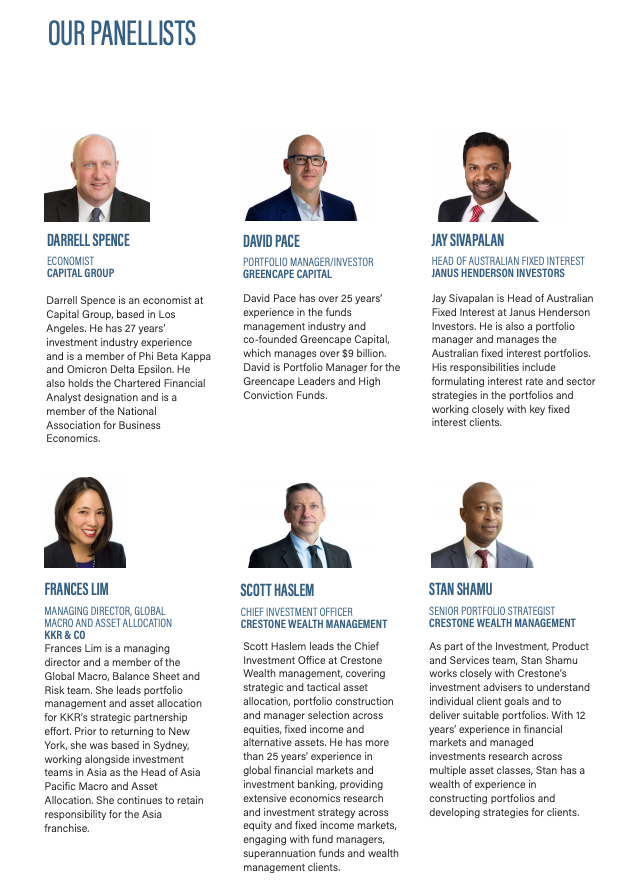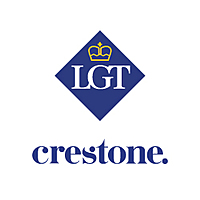Navigating volatile markets
The global economy is emerging from a pandemic-led recession in the first half of 2020—the deepest in modern history. While growth in the latest quarter is likely to show a strong rebound for most economies, much uncertainty remains about the shape of the recovery over the rest of this year and its sustainability in 2021.
Near-term risks centre around the prospect of fading fiscal support, an uncertain US election result with the risk that the outcome is contested, as well as the recent resurgence in COVID-19 cases in a number of countries. While Australia’s outlook remains critically linked to global
developments, hopes for eased lockdown restrictions on the back of improving virus trends, as well as expectations for additional fiscal stimulus, have recently improved near-term domestic growth prospects.
At Crestone’s most recent investment forum, we asked panellists to discuss their near-term outlook given these current uncertainties. In particular, we asked how they view the most likely central case scenario for global and Australian growth over the coming year. Key strategies for investing across different asset classes were explored in light of relatively expensive equity and sovereign bond markets.

Overall, while our panellists were constructive on the prospects of a pick-up in economic growth in 2021, caution was a common theme dominating discussions regarding the investment environment for the rest of 2020. Uncertainties surrounding a potential vaccine, the outcome of the US election, and ongoing deliberations about further fiscal stimulus were viewed as likely to generate an elevated level of volatility over coming months.
Three key themes emerged from the forum
- The virus and fiscal stimulus risks are weighing on the near-term outlook—The resurgence of the virus is challenging notions the pandemic is a finite event. There is a risk, given stalled US stimulus talks, that the ‘fiscal bridge’ being built may not reach far enough. More positively, there were signs societies are learning to live with the virus without resorting to full lockdowns. The US election, and the potential for the outcome to be contested, was viewed as driving near-term market volatility.
- There are reasons to be optimistic about Australia’s recovery—Australia is in a relatively strong economic position after 29 years of growth, and with less structural risks in household debt and bank funding than several years ago. Despite risks around fading fiscal stimulus, there was some likelihood that prior support would underpin a genuine resurgence in demand when restrictions eased. However, any recovery was expected to be uneven, given the economic shock was uneven.
- Investment opportunities still exist, despite expensive markets—Finding value in equities will require accepting a long-term horizon, as fully valued markets are likely to churn sideways near term. Opportunities exist in cyclical re-opening trades, companies with strong cost control prospects and emerging markets. In fixed income, the ‘sweet spot’ for investors is to employ a shorter duration strategy and seek income in higher quality segments of credit. Unlisted real assets are an increasingly attractive source of defensive yield and asset growth.
What are the challenges facing Australia?
Since the onset of the pandemic, the Australian Government has deployed a number of stimulus measures to kick-start the economy. In coming months, however, these measures could be wound down—but is it really likely that the domestic economy will grind to a halt?
How will fading stimulus affect the domestic economic recovery?
According to David Pace, Portfolio Manager at Greencape Capital, Australia has a build-up of stimulus in the system, thanks to the JobKeeper program. How the economy responds once this stimulus ends will be key.
“While there was instant gratification in terms of the economic response, which will likely compound once borders re-open, a recession still looms. The best-case scenario is a U-shaped recovery, but there are quite a number of businesses that will go to the wall before we get through that.”
Pace believes that clarification is still needed on how much is genuine demand with follow-through, as opposed to pent-up demand as a result of the shutdowns in March and April. He notes that in the US, as the economy has re-opened, the resurgence in housing demand has been profound and it has taken everybody by surprise. Scott Haslem, Chief Investment Officer at Crestone Wealth Management noted the strong multiplier effect that comes from housing activity in economies and that, in Australia’s case, this could feed through and support other parts of the economy.
What are the key risks and challenges facing Australia?
Jay Sivapalan, Head of Australian Fixed Interest at Janus Henderson Investors, believes the domestic economy was not necessarily broken to begin with. “We had 29 years of continuous growth. When you have that long period of economic growth, you typically get some excesses building up. In Australia’s case, the risks were clearly around household debt. However, many of the steps that were taken by APRA and the banks over the last five years—a tightening of lending standards, a focus on serviceability— have helped to the extent that when you get a left-field shock like this you can work through it appropriately. Additionally, we have strong capital levels by historical and global standards. Today, banks are two thirds funded by deposits, as opposed to one third when they were heading into the GFC.”
Sivapalan highlighted a key difference between Australia and the US was the slack in the jobs market heading into the crisis. Unemployment in the US (at a 50-year low) prior to the crisis was a particular strength. He feels that, domestically, we are contending with slower moving challenges, such as the use of technology in the transition to online consumption, and the way we do business, as well as the effects of the 2019 bushfires. However, unlike offshore, there was significant capacity for monetary stimulus and lower bond yields have led to a significant drop in funding costs. “We’ll have to contend with the pace of permanent disruption, the reorganisation of the economy and acceleration of tech trends—all the while working through a default cycle during this recession.”
Sivapalan believes that further stimulus is highly likely and necessary to the sectors hardest hit. He feels the recovery will likely be uneven because the shock was uneven. There has been a serious dent to the economy and we will need to work through that. So, when it comes to retracing growth, he expects it will not be until late 2022 before we fully recover.
The Crestone view: Falling virus case trends, the prospect of additional fiscal and monetary stimulus, and the ongoing recovery in China and the global economy are underpinning some improvement in Australia’s economic outlook.
What does this mean for Equities?
Low rates and various stimulus measures since the GFC have resulted in equity valuations rising above long-term averages. However, focusing on traditional valuation measures, such as price-to-earnings ratios, may not provide the full picture.
How do you balance valuation, concentration and zero interest rates?
Pace believes there has been a pretty big downgrade washout in Australia’s August reporting season and, while he is quite comfortable with where consensus numbers have landed, the problem is elevated multiples. He feels the time for portfolio triage and repair has come and gone. Additionally, low rates are great until they are terrible. He cautions that discounting cashflows involves more than just the risk-free rate and feels “the lower the rates, the louder the alarm bells” when it comes to equity risk premia.
Haslem feels the issue is not as simple as growth versus value—it is about which companies have positioned themselves through the crisis for future growth.
At Greencape Capital, Pace explained that they are adding duration (the period they expect the share price to converge on fair value) at a measured rate. They are also assessing companies that have been structurally impaired by the pandemic but are expecting a solution on a two to three-year timeframe. He believes it is important to hone in on companies that have used the crisis to their advantage, such as those that have reset their cost bases substantially. For example, Qantas, which is highly unionised, has a once-in-a-lifetime opportunity to reset its cost base. Over the medium term, Pace believes that equity yield will play a big role in total shareholder return outcomes. He thinks investors should look for sustainable yield (i.e. companies that are generating good levers of cash so payout ratios are manageable and yields are sustainable) that has an element of self-funding growth. This, he believes, is a reasonable total shareholder return equation. The further out he looks, the greater Pace’s conviction, as he does not see short-term risk-adjusted value on the table. He sees great opportunities on a three to five-year time horizon.
Frances Lim, Managing Director at KKR & Co believes the only measure that does not look expensive is if you compare either the earnings yield or dividend yield relative to interest rates. “You also have to focus on the equity risk premium. Over time, it is relatively stable, so that’s the right measure because it’s mean reverting and in today’s market it’s at the lower end of that band.”
When Lim thinks about how this will evolve, she explains,
“we are fully valued today, and the market normally churns a lot when it’s fully valued. Following the strong rebound in markets, we’re past the easy wins. Here is where we trade sideways and you have to pick your spots.”
She explains that it is difficult to justify buying the big five stocks above these levels. There is, however, value in some of the cyclical names should a vaccine emerge. However, the adoption of a vaccine is not yet known, and we are unlikely to see a full recovery until 2022.
An exchange of investment ideas
The Crestone Investment Forum brings together the brightest minds in the industry to discuss the global outlook for equities, bonds and where they are allocating their incremental dollar. Download the full report here.
1 stock mentioned
4 contributors mentioned

